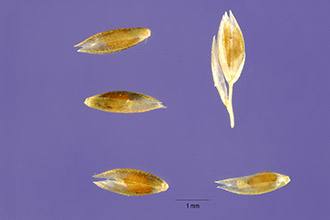Sporobolus cryptandrus (Torr.) A. Gray var. strictus Scribn.
Scientific Name: Sporobolus cryptandrus (Torr.) A. Gray var. strictus Scribn.

| General Information | |
|---|---|
| Usda Symbol | SPCRS |
| Group | Monocot |
| Life Cycle | Perennial |
| Growth Habits | Graminoid |
| Native Locations | SPCRS |
Plant Guide
Use soil moisture sensors to measure the soil moisture of Sporobolus cryptandrus (Torr.) A. Gray var. strictus Scribn..
Fact Sheet
Uses
Erosion Control: Spike dropseed may be used as a component of a seeding mixture for critical area plantings and conservation cover. It is a bunchgrass with very thick vegetation near the soil surface which can be used to stabilize sandy eroding soils. Wildlife: Spike dropseed is utilized as a food source by various wildlife species. Particularly, upland birds feed on the mature seed that is produced. It also provides good cover for birds and small mammals. Livestock: Many species of livestock will graze on spike dropseed. It has a nutritional value of fair. The species has the ability to recover and reseed itself if heavy grazing occurs.
Status
Please consult the PLANTS Web site (http://plants.usda.gov) and your State Department of Natural Resources for this plant’s current status (e.g. threatened or endangered species, state noxious status, and wetland indicator values).
Weediness
This plant may become weedy or invasive in some regions or habitats and may displace desirable vegetation if not properly managed, Please consult your local NRCS Field Office, Cooperative Extension Service office, state natural resource, or state agriculture department regarding its status and use, Weed information is also available from the PLANTS Web site at http://www,plants,usda,gov , Please consult this and Related Web Sites and view the plant profile for this species for further information, , Use soil moisture sensors to measure the soil moisture of Sporobolus cryptandrus (Torr.) A. Gray var. strictus Scribn..
Description
Spike dropseed is a native, perennial, warm season bunchgrass with erect stems that grow 3 feet tall. It begins growing in the spring when moisture levels increase and matures to produce seed in October. The leaf blades grow to about 1.5 feet long and ½ inch wide. The leaves are flat when the plant is actively growing, but as the plant begins to dry, they become V-shaped. The sheaths of the leaves are hairy along the margins. The seedhead is ½ inch wide and six inches to approximately 1.5 feet long.
Adaptation
Spike dropseed is adapted to a large portion of the southwest United States. It is found from Texas to California, and as far north as Nevada and Colorado. Spike dropseed is adapted to a wide range of soil types, but performs best on loamy fine, silty and sandy loam soils. Distribution: Please consult the Plant Profile page for this species on the PLANTS Web site.
Establishment
Spike dropseed should be planted on a clean, firm seedbed. Planting can be done using either a grass drill or broadcast seeding, but grass drills are the most successful method of planting. Seed should be placed less than 1/8 inch deep on fine textured and ½ inch on sandy soils. Spike dropseed should be planted at a rate of 1.0 lb pure live seed (pls) per acre. When planting spike dropseed as a component of a seed mixture, the seeding rate should be adjusted to the desired percent of the mix. Soil samples should be taken before planting to determine the amount of fertilizer needed to bring the fertility level up to a medium range. Nitrogen should be limited to less than ten pounds per acre until a stand is evident.
Management
Spike dropseed is commonly found as a component in seed mixtures for range and pastures. Stands of spike dropseed should be well established before livestock grazing is permitted. Once the stand is established, spike dropseed should never be grazed or cut below five to six inches. Grazing can begin the first winter after planting on well established areas. Spike dropseed can reseed
Pests and Potential Problems
None Known

